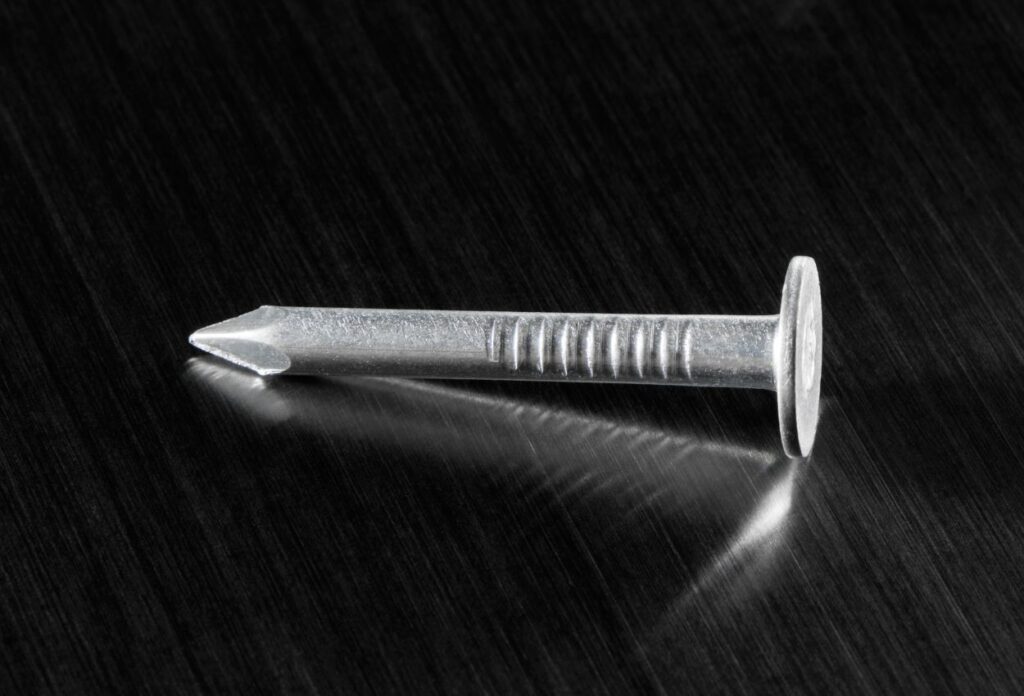Instant Roof Quote
 ×
×
South MS: (601) 520-3183
North MS: (662) 636-7663
North AL: (256) 692-5527
Meridian, MS: (601) 841-3218
Do You Need To File An Insurance Claim
Posted on April 21, 2025

When it comes to roofing, even the smallest parts, like nails, can make a big difference in how long your roof lasts and how well it holds up. Galvanized roofing nails may seem simple, but they’re very important because their special coating helps protect your roof from weather damage. You might wonder why roofing nails have to be galvanized, why it matters, and how to pick the right ones for your roof.
In this blog post, we will break it all down so you can make smart choices for your next roofing project.
Galvanized roofing nails are made of steel and covered with a layer of zinc, which protects them from rust and corrosion. This coating is added through methods like electro-galvanization or hot-dipping. These nails are important for holding down roofing materials like shingles and felt, especially in places with lots of rain, moisture, or rough weather. They have wide, flat heads and sharp points, making them easy to hammer in without hurting the wood or shingles. Galvanized nails are a popular choice because they’re strong, affordable, and follow building codes, helping your roof stay secure and last longer.
Also Read: How to Nail Roofing Shingles: A Step-by-Step Guide?
Next, let’s go over the different ways roofing nails are coated with zinc and how each method differs.
In this method, steel nails are dipped into hot, melted zinc at high temperatures, around 830 degrees Fahrenheit. This creates a thick, strong coating that protects the nails from rust and helps them last, even in tough weather. The zinc layer is thick, which is why hot-dip galvanized nails are great for outdoor use and can stay rust-free for decades, especially in suburban areas.
This method uses electricity to coat steel nails with a thin layer of zinc in a liquid solution. The result is a shiny, smooth finish, but the coating is much thinner, so it doesn’t protect as well as hot-dip galvanization. These nails are better for indoor projects or short-term outdoor use since they can rust faster when exposed to moisture.
With this method, nails are placed in a spinning drum with zinc powder and small beads. The impact sticks the zinc onto the nails, creating a smooth and even coating. This offers decent protection but not as much as hot-dip galvanized nails. It’s usually used where nails won’t face extreme weather.

Here’s why using galvanized nails can save you trouble and money in the long run.
Galvanized nails are covered with a layer of zinc that protects the steel inside from rusting. This helps them stay strong and last much longer than regular roof nails. The zinc acts as a shield, breaking down first so the steel remains protected, making galvanized roofing nails a dependable choice.
The zinc coating also acts as a barrier against moisture, oxygen, and salt, which are common causes of rust. This makes nails for roofing especially useful for outdoor work or in damp places, including coastal areas where salt in the air can speed up corrosion. If you’ve noticed rust on a roof nail, switching to galvanized nails can prevent that.
These roofing nails are useful in all sorts of jobs like construction, woodworking, and masonry. They work both indoors and outdoors and can be used with materials such as wood, stone, or metal. Whether it’s for shingle nails, building decks, or even cabinet work, a galvanized nail is a reliable choice.
While galvanizing nails may cost a bit more upfront, their long-lasting strength means fewer repairs and replacements later. This makes them a smart investment, especially compared to more expensive options like stainless steel. Using galvanized nails ensures durability without breaking the budget.
Many galvanized nails have a rough or textured surface that helps them grip better. This added grip keeps them secure even when materials shift or move, which is helpful for projects like framing or decking that need strong, steady support from quality roofing nails.
Even if the zinc layer on the roof nail gets a small scratch, it can still protect the steel underneath. This self-healing quality keeps the nails strong, making them dependable even in tough conditions.
Hot-dipped galvanized nails have a thicker layer of zinc than other types, making them more weather-resistant. They handle temperature changes, humidity, and rain well, which is why they are perfect roof nails for outdoor jobs that need to last a long time.
If you skip galvanized nails, you may face issues like:
Without the zinc coating that protects galvanized nails, regular roof nails can rust quickly. When steel is left open to air and moisture, it starts to corrode, which weakens the nail and can damage the material it’s holding.
As roofing nails rust, they lose their grip. This can cause parts of the structure to come loose or fall apart, especially in important areas like roofs or decks. That’s why using strong nails for roofing matters.
Rusty roof nails can leave behind brown or orange stains on wood or other surfaces. This doesn’t just look bad, it’s a big issue for places where appearance counts, like siding or trim.
If you’re using non-galvanized nails, be ready to fix things more often. As the nails rust and break down, you’ll spend more time and money replacing them. In the long run, it’s just not worth the trouble.
Regular shingle nails don’t last nearly as long as galvanized nails. This means parts of your home might wear out sooner, and you’ll need to do repairs or rebuild more often.
In serious cases, rusted roof nails might not hold things together properly. This could lead to shingles or flashing falling off, which can be dangerous, especially if the nails were holding up something heavy or load-bearing.
Galvanized roofing nails, coated with zinc, are a better choice than non-galvanized ones because they resist rust and corrosion, making them more durable for outdoor use. Among these, hot-dipped galvanized nails offer the best protection thanks to their thicker zinc layer. While regular nails may cost less upfront, they rust easily and need frequent replacement, so galvanized nails are a more reliable and cost-effective option over time.
When it comes to protecting your home, you shouldn’t have to compromise on getting quality roofing services. At B & A Roofing and Gutters, we know how important it is to use quality materials and expert workmanship to keep your roof strong. That’s why we use premium roofing nails and rely on skilled professionals who focus on precision and long-lasting results. Whether you need a roof inspection, repair, or full replacement, we’re here to make sure your roof is in the best shape. Reach out to us today at (601) 520-3183 and see the difference quality can make.
Most shingles need at least four nails, but in areas with strong winds or steep roofs, it’s better to use six. Always check the manufacturer’s guide, as they may recommend more shingle nails based on weather or roof slope.
Nail the shingles along the line marked by the manufacturer. This is usually just below the sealant strip and above the visible part of the shingle. Keep the roofing nails at least 1 inch away from the edges and avoid placing them over joints or cutouts.
Don’t see your location? Call us! We Likelt serve your area too